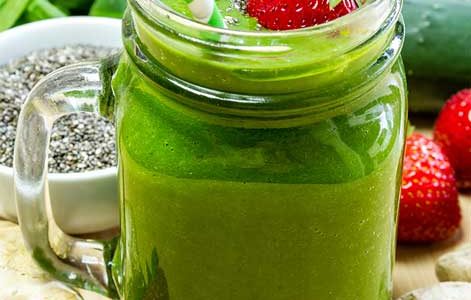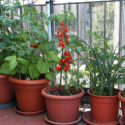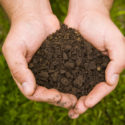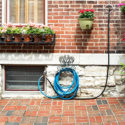Do you like smoothies? You want to know how to grow some of the plants you use to make them? It couldn’t be more simple! Plant them in containers on your patio, near the kitchen. Below, a description of some plants that are easy to grow in containers and that will be perfect in your smoothies!
Kale ‘Darkibor’
(Brassica oleracea var. acephala ‘Darkibor’)
This kale is precocious and easy to grow. Its leaves can be harvested over several months, starting in August. In addition to being edible, this plant has multiple properties and is highly decorative with its very crispate bluish green foliage. It is also very hardy, as it can easily tolerate temperatures as low as –10 °C. Its leaves can be harvested through December, and even in January if the winter is mild. It’s assuredly one of the most popular plants when it comes to making smoothies.
Kale seed can be started outdoors, in pots, towards the end of May or in June. However, it is preferable to start them indoors, in April, that is, about six weeks before the last expected frost. The seed must be seeded in a rich soil containing compost, peat moss and perlite, such as PRO-MIX® Organic Vegetable and Herb Mix, at a depth of 13 mm (1/2 in). It is highly recommended to transplant kale seedlings outside once the cabbage maggot is finished laying its eggs (usually in early June), as its larvae feed on cabbage and kale roots. You can also find nice potted kale plants in some garden centers and nurseries.
Pineberry Natural Albino®
(Fragaria x ananassa Natural Albino®)
Now, here’s a highly original strawberry cultivar producing white fruits covered with small red seed early in the summer. Some say its taste is similar to pineapple. Pineberry Natural Albino® isn’t self-fertile. Therefore, it must be planted with one or two other pineberry plants to ensure pollination. In full sun, this plant will quite easily resist southern Ontario’s and southern Quebec’s winters, especially if it is grown in a fabric pot such as a Smart Pot. Pineberry Natural Albino® is sold as a potted plant in some Canadian garden centers.
Malabar nightshade
(Basella alba)
This climbing plant was named after the region of Malabar, in India, where it comes from. In a tropical environment, it will reach up to 6 meters in height, but under our climate, it will grow about 2 meters high during a warm, humid summer. That is why, ideally, an obelisk or stake should be installed in the pot in which it is grown. Its young oval, fleshy leaves can be eaten raw or cooked, just like spinach. They can also be used to prepare smoothies. The Malabar nightshade must be grown in full sun, in a compost-rich soil. Keep the soil wet at all times. It must be started indoors in April, 6 to 8 weeks before transplanting outside. This will be done at the same time as basil, that is, towards the end of May or in early June. Soak the seed in water overnight before seeding.
Blueberry Jelly Bean™
(Vaccinium corymbosum Jelly Bean™ )
If you could only grow one fruit shrub to make smoothies this summer, I highly recommend that you choose Blueberry Jelly Bean™. This small shrub, specifically developed for container production, produces an abundance of fruits with numerous properties. Being among the richest in antioxidants, blueberries are known to reduce abdominal fat and prevent hypertension. Towards the end of spring, Blueberry Jelly Bean™ produces small white droopy flowers, and then, in July and August, dark blue fleshy fruits that are slightly acidulous. In the fall, its foliage turns bright red. Resembling a box tree with its very dense, round-shaped foliage, Blueberry Jelly Bean™ will reach a maximum of 60 cm in height. Its flower buds can resist temperatures as low as –32 °C.
It is preferable to install this shrub in full sun or partial shade, well protected from prevailing winds. Furthermore, it prefers acidic soils that are moist, light and well drained. A peat-based potting soil, such as PRO-MIX® Premium Potting Mix, will work just fine, provided a little powdered sulphur is added to slightly acidify it.



